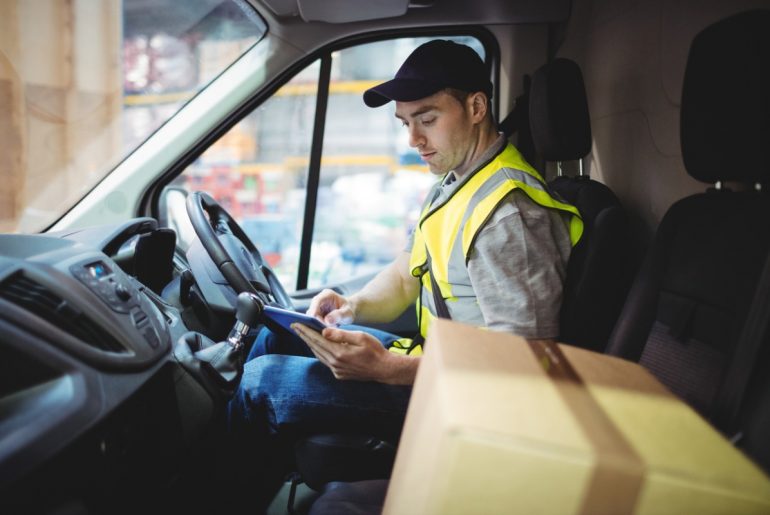Last-mile delivery tracking is a fast-growing trend in the delivery world. With so many more people ordering items every day, companies have seen the need for transparency and communication.
Last-mile carrier tracking is one of the most vital aspects of any delivery and the most crucial part to the client.
Any company that wants to keep up with demands has to make the move to include detailed last-mile carrier tracking. It is a way to satisfy the client, help them work out appropriate delivery times, and allow the company to better track their interaction and make improvements.
Modern Expectations
Let’s be real for a moment. People are busier in their daily lives now than they have ever been in history. A mom that works a full-time job, picks up two kids from school, makes dinner, takes the kids to soccer practice, and grabs groceries in the meantime all while having a phone meeting with work doesn’t have time to worry about the exact time her package will arrive.
Customers have come to expect reliability and visibility in package tracking and want regular updates to ease their minds and plan their schedules around. This busy mom can rest easy knowing that when she asks for the delivery at 5 pm on Sunday, it will be there. She can see it driving closer, and the driver said it will be there in half an hour. Now she doesn’t need to spend her only night off in a state of constant waiting.
Nearly 100% of customers have come to expect tracking numbers, updates, and total visibility in their deliveries nowadays. People don’t have time to stress over a delivery and companies know this. All the biggest companies to have blown up over the recent increase in delivery orders have real-time last-mile tracking and detailed, personalized updates.
But what is last-mile tracking, and why don’t you have it yet?
What is the Last-Mile?
The last mile, while in some cases can be an actual mile, usually refers to the last transport transaction before the final drop-off point.
If a package has gone through warehouses and airports from China to New Jersey, US, with a final destination of a New York apartment, then the last mile would be the section of the journey from the last holding point to the customer’s house.
While customers have come to expect the tracing list, forward-thinking companies also include further details on the last leg of the journey to improve their visibility and help customers plan around the delivery.
What Does Last-Mile Carrier Tracking Entail?
The name of the game when it comes to the last mile is real-time tracking. With the invention of new technologies and the downsizing of systems like GPS, customers can now get far more transparency and accuracy in their deliveries than ever before.
The join and satisfaction that anticipation brings make a substantial difference to how customers view a shipping service. Waiting is never fun, but knowing where your package is at any given moment alleviates stress and makes the client feel like they’re traveling with it.
Not having accurate tracking and updates makes the client feel like their package is lost in the void and may never surface. It makes them stressed and brings disdain for the company, especially if they paid a lot for shipping.
While companies can choose to have their last-mile tracking set up in different ways, some common aspects include:
- A text or email notification the morning of the delivery or several hours before
- A direct line to the driver or delivery service
- A detailed account of location transactions and tracking number
- A real-time display of the driver’s proximity and ETA
- A system to rate or leave reviews post-delivery
Visibility in last-mile tracking is one of the most important aspects that give modern companies an edge. Gone are the days of ordering a delivery and patiently waiting for it to appear on your doorstep. Customers want to know exactly where their package is at all times, especially when they need to be home to pick it up.
With the rise of package thieves, last-mile tracking serves a dual purpose. It helps the client feel reassured that their package has been delivered safely, and they can plan around when they need to rescue it from their doorstep or talk to the driver to have it delivered at a different time. It also covers the back of the delivery company as the client can clearly and irrefutably tell whether or not the package was delivered.
Why it Matters to the Customer
As a customer, you don’t want to be left wondering when your package will arrive or if it is delayed. It can be frustrating to look at a transfer list and see that your package has been sitting in your city for three days.
The last mile tracking system helps put anxieties to rest by detailing where and why the package is where it is. It also allows the client freedom to get on with their life when they know exactly when to expect their delivery. Now they can get groceries and pick up their kid without stressing about package thieves.
It is also helpful when something changes last minute, and a customer will no longer be at home when they thought they would be. With a quick few clicks or a text, you can tell the driver to make other arrangements.
Last-mile tracking makes the process worry-free for the client.
Why it Matters to the Company
As a business owner, your goal is always to optimize your workflow and satisfy your customers. The more detailed your tracking is, the easier it is to collect data on every stage of the process and make adjustments for hang-ups and slowdowns. By being transparent with your service, you prove to the client that you are confident in the process and everything is functioning correctly. And that when it doesn’t, the client isn’t left to wonder.
Last-mile tracking is a huge part of this process as it can give you more personal data on when the best delivery times are in different areas, and direct feedback from the client allows you to better tailor the experience. While last-mile tracking initially improved the company’s appearance and made them seem innovative and approachable, it has now become the standard, and any company without it risks falling behind.
From a logistical standpoint, offering last-mile tracking isn’t that much more work on top of the ongoing process.
Last-mile tracking provides helpful feedback, better records, and chances to improve for the company.
FAQ
What does it mean “accepted by last-mile carrier”?
As implied, “accepted by last-mile carrier” means your package is (possibly quite literally) in the hands of the final carrier. Once the item is with the driver, it will take a day or two to reach your home and its final destination.
How long does last-mile carrier take?
The duration of last-mile delivery can vary greatly, taking anywhere from a few minutes to several days. If you order through a service like Doordash or UberEats, then the last-mile tracking is the entire process and can take as little as 20 minutes.
However, if you have ordered something from overseas with standard shipping, the last mile can take several days to a week. Even when a package is out for delivery, it may not get dropped off that day.
The ideal last-mile delivery system gives the client 1 or 2 days of detailed tracking from the last transfer point to their home.
How much does last-mile delivery cost?
Oddly enough, the last mile is the most expensive leg of the journey. It usually requires over a third of the total shipping cost or around 41%. This stage requires more detailed and hands-on work. As the package gets closer to its destination, the carrier continuously scales down, and by the time the package is out for the last mile, it is usually in a small truck with one driver.
It’s much less expensive to ship a load of cargo by a freight train as compared to a single item by hand and truck. when the package is part of a cargo shipment, there’s a bulk deal. When it is in the last stage, you are paying for every individual item.
In Summary
Last-mile carrier tracking is a process that allows the client better visibility of their package’s movements between the last transfer point and the final destination. It often accompanies a way to talk to the driver or service, real-time updates on ETA, and morning-of notifications of delivery.
Last-mile tracking is a must for any company that wants to stay ahead and give its customers the best service.




